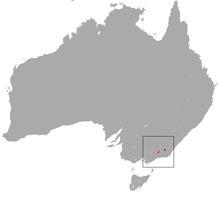| Mountain pygmy possum Temporal range: Pleistocene – Recent
| |
|---|---|

| |
| Scientific classification | |
| Domain: | Eukaryota |
| Kingdom: | Animalia |
| Phylum: | Chordata |
| Class: | Mammalia |
| Infraclass: | Marsupialia |
| Order: | Diprotodontia |
| Family: | Burramyidae |
| Genus: | Burramys |
| Species: | B. parvus
|
| Binomial name | |
| Burramys parvus Broom, 1896
| |

| |
| Mountain pygmy possum range | |
The mountain pygmy possum (Burramys parvus), also simply known as the burramys,[2][3] is a small, mouse-sized (weighs 45 grams (1.6 oz)) nocturnal marsupial of Australia found in dense alpine rock screes and boulder fields, mainly southern Victoria and around Mount Kosciuszko in Kosciuszko National Park in New South Wales at elevations from 1,300 to 2,230 metres (4,270 to 7,320 ft).[1] At almost 14 cm (5.5 in), its prehensile tail is longer than its 11 cm (4.3 in) combined head and body length. Its diet consists of insects (such as the bogong moth), fleshy fruits, nuts, nectar and seeds. Its body is covered in a thick coat of fine grey fur except for its stomach, which is cream coloured; its tail is hairless. On the underside of the female's body is a pouch containing four teats. This possum is the only extant species in the genus Burramys.[4] It is also the only Australian mammal restricted to alpine habitat.[1]
- ^ a b c Menkhorst, P.; Broome, L.; Driessen, M. (2008). "Burramys parvus". IUCN Red List of Threatened Species. 2008: e.T3339A9775825. doi:10.2305/IUCN.UK.2008.RLTS.T3339A9775825.en. Retrieved 19 November 2021.
- ^ "A guide to all 27 species of Australia's possums and gliders". Australian Geographic. 25 July 2019. Retrieved 8 January 2021.
- ^ Mansergh, Ian; Kelly, Paul; Johnson, Glen (2003) [1991]. "Flora & Fauna Guarantee Action Statement" (PDF). Department of Sustainability and Environment. 2: 5. ISSN 1448-9902.
- ^ Groves, C. P. (2005). "Order Diprotodontia". In Wilson, D. E.; Reeder, D. M (eds.). Mammal Species of the World: A Taxonomic and Geographic Reference (3rd ed.). Johns Hopkins University Press. p. 44. ISBN 978-0-8018-8221-0. OCLC 62265494.
